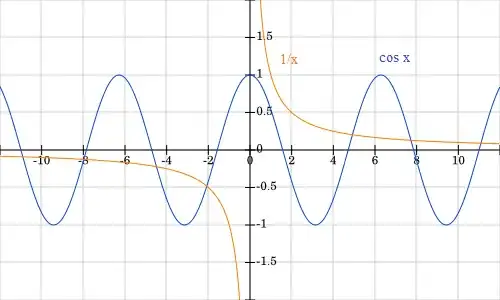To finding the roots of $x \cos{x}-1=0$ we can write the equation as $$ f(x)=x \cos{x}-1=0 \to x \cos{x}=1 \to \cos{x}=\frac{1}{x} \to \cos{x}-\frac{1}{x}=u(x)-v(x)=g(x)=0 $$ The roots of $f(x)$ are exactly the same roots of $g(x)$. But $f(x)\ne g(x)$. How can it be correct?

Edit: My question is: Can we always simplify the equation (changing $f(x)=0$ to $u(x)-v(x)=0$) to finding the roots?
Edit 2: The main problem is that it is much easier to finding the roots graphically by writing $f(x)$ as difference between two functions $u(x)-v(x)$. Then the roots of $f(x)$ are the intersections of the two functions $u(x)$ and $v(x)$.
Edit 3: The problem is NOT where the two functions $f(x)$ and $g(x)=u(x)-v(x)$ obtained from $f(x)$ by adding or multiplying in the right and left of $f(x)=0$ are defined. The problem is are the roots of $f(x)$ equal to the roots of $g(x)$ or intersections of the two functions $u(x)$ and $v(x)$? Are there counterexamples in which the the roots of $g(x)=u(x)-v(x)$ are not equal to original function $f(x)$?
Edit 4: Can we eliminate $x/x$ from $(x \cos{x})/x=1/x$ to obtain $\cos{x}- (1/x)=0$ ? I think I shouldn't do that. But in my textbook the author does that.
